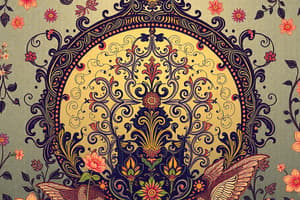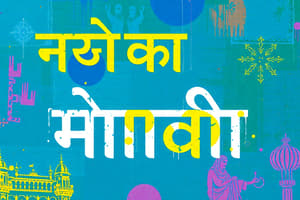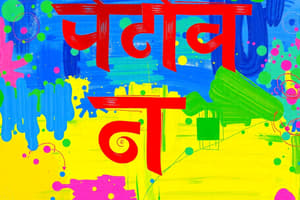Podcast
Questions and Answers
Which historical language is considered the direct ancestor of Hindi?
Which historical language is considered the direct ancestor of Hindi?
- Sauraseni Apabhramsa
- Classical Sanskrit
- Shauraseni Prakrit
- Vedic Sanskrit (correct)
Modern Standard Hindi is based on which dialect?
Modern Standard Hindi is based on which dialect?
- Khariboli (correct)
- Awadhi
- Braibhasha
- Bhojpuri
According to the Indian Constitution, what script is specified for the official language of the Union?
According to the Indian Constitution, what script is specified for the official language of the Union?
- Devanagari script (correct)
- Roman script
- Bengali script
- Persian script
Which of the following is NOT a state within the 'Hindi Belt' of India?
Which of the following is NOT a state within the 'Hindi Belt' of India?
What is the primary function of the Official Languages Act of 1963 concerning Hindi and English?
What is the primary function of the Official Languages Act of 1963 concerning Hindi and English?
Which language family does Hindi belong to?
Which language family does Hindi belong to?
What is the most common word order in Hindi sentences?
What is the most common word order in Hindi sentences?
In which century did Modern Standard Hindi emerge as a distinct language?
In which century did Modern Standard Hindi emerge as a distinct language?
In what fundamental way does Hindi grammar differ from English grammar in its use of prepositions?
In what fundamental way does Hindi grammar differ from English grammar in its use of prepositions?
What is the most accurate characterization of the relationship between Hindi and Urdu?
What is the most accurate characterization of the relationship between Hindi and Urdu?
What is the significance of the 'inherent vowel' concept in the Devanagari script?
What is the significance of the 'inherent vowel' concept in the Devanagari script?
Which of the following is the most accurate broad classification of loanwords (videshaj) found in the Hindi language?
Which of the following is the most accurate broad classification of loanwords (videshaj) found in the Hindi language?
If you were studying the historical development of Hindi literature, why would Braj Bhasha be an important area of focus?
If you were studying the historical development of Hindi literature, why would Braj Bhasha be an important area of focus?
What role did the Bhakti movement play in the evolution of Hindi literature?
What role did the Bhakti movement play in the evolution of Hindi literature?
Why is Bharatendu Harishchandra often referred to as the 'father of modern Hindi literature'?
Why is Bharatendu Harishchandra often referred to as the 'father of modern Hindi literature'?
What distinguishes 'tatsam' words from 'tadbhav' words in Hindi vocabulary?
What distinguishes 'tatsam' words from 'tadbhav' words in Hindi vocabulary?
How has the growth of the internet and social media impacted the Hindi language?
How has the growth of the internet and social media impacted the Hindi language?
Why has the promotion of Hindi as a national language in India faced resistance, particularly in non-Hindi speaking regions?
Why has the promotion of Hindi as a national language in India faced resistance, particularly in non-Hindi speaking regions?
Flashcards
What is Hindi?
What is Hindi?
Indo-Aryan language, official language of the Union government of India, and one of the 22 scheduled languages of India.
Hindi's Linguistic Ancestry
Hindi's Linguistic Ancestry
Vedic Sanskrit -> Classical Sanskrit -> Prakrits -> Shauraseni Prakrit -> Apabhramsa -> Early Hindi.
What is the Hindi Belt?
What is the Hindi Belt?
A region in northern and central India where Hindi is widely spoken.
Article 343(1)
Article 343(1)
Signup and view all the flashcards
Official Languages Act of 1963
Official Languages Act of 1963
Signup and view all the flashcards
Hindi Grammar Elements
Hindi Grammar Elements
Signup and view all the flashcards
Verb Conjugation Factors
Verb Conjugation Factors
Signup and view all the flashcards
Common Word Order
Common Word Order
Signup and view all the flashcards
Postpositions in Hindi
Postpositions in Hindi
Signup and view all the flashcards
Hindustani
Hindustani
Signup and view all the flashcards
Tatsam Words
Tatsam Words
Signup and view all the flashcards
Tadbhav Words
Tadbhav Words
Signup and view all the flashcards
Deshaj Words
Deshaj Words
Signup and view all the flashcards
Videshaj Words
Videshaj Words
Signup and view all the flashcards
Khariboli
Khariboli
Signup and view all the flashcards
Abugida Script
Abugida Script
Signup and view all the flashcards
Devanagari direction
Devanagari direction
Signup and view all the flashcards
Modern Hindi Literature
Modern Hindi Literature
Signup and view all the flashcards
Study Notes
- Hindi is a chief Indo-Aryan language in India.
- It is the official language of the Union government of India.
- Some Indian states and union territories also recognize it as an official language.
- Hindi is one of the 22 scheduled languages of India.
- As a linguistic variety, Hindi serves as the base or central language of the Hindi Belt.
- Modern Standard Hindi is a standardization of the Khariboli dialect.
History and Development
- Vedic Sanskrit is the ancestor of Hindi.
- Vedic Sanskrit evolved into Classical Sanskrit.
- Prakrits were derived from Sanskrit.
- Shauraseni Prakrit was an important Prakrit.
- Various Apabhramsa languages emerged from Shauraseni Prakrit.
- Sauraseni Apabhramsa was one such language.
- The Northern branch of Sauraseni Apabhramsa gave rise to early forms of Hindi.
- These early forms are referred to as Old Hindi.
- Old Hindi gradually evolved into Middle Hindi.
- Modern Standard Hindi emerged in the 19th century.
- British administrators and Indian intellectuals promoted it.
- The standardization was based on the Khariboli dialect of the Delhi region.
- Modern Hindi's literary tradition developed in the 19th and 20th centuries.
- Bharatendu Harishchandra played a significant role in its development.
Geographical Distribution
- Hindi is primarily spoken in the Hindi Belt of India.
- The Hindi Belt includes states like Uttar Pradesh, Madhya Pradesh, Bihar, Haryana, Rajasthan, Uttarakhand, Chhattisgarh, Himachal Pradesh, Jharkhand, and Delhi.
- Significant Hindi-speaking populations exist in other parts of India.
- Outside India, Hindi speakers are found in countries with Indian diaspora populations.
- These include Nepal, Mauritius, Fiji, Guyana, Trinidad and Tobago, Suriname, and the United Arab Emirates.
Official Status
- Hindi is an official language of the Union government of India.
- English is the other official language.
- Article 343(1) of the Constitution states that Hindi in Devanagari script is the official language of the Union.
- The Official Languages Act of 1963 allows for the continued use of English alongside Hindi in official communication.
- Some states and union territories in India have declared Hindi as an official language.
Linguistic Features
- Hindi is an Indo-Aryan language.
- It shares linguistic features with other Indo-Aryan languages.
- Hindi grammar includes nouns, pronouns, verbs, adjectives, adverbs, and particles.
- Hindi verbs conjugate for tense, aspect, mood, gender, and number.
- Hindi has a relatively free word order, but SOV (subject-object-verb) is common.
- Hindi uses postpositions rather than prepositions.
- Hindi's phonology includes aspirated and unaspirated consonants.
- Retroflex consonants are also present.
Relationship with Urdu
- Hindi and Urdu are considered mutually intelligible.
- They share a common grammatical base called Hindustani.
- The primary difference lies in vocabulary.
- Hindi draws vocabulary from Sanskrit.
- Urdu draws vocabulary from Persian and Arabic.
- In formal settings and literature, the distinction between Hindi and Urdu is more pronounced.
- Colloquially, the spoken language is often referred to as Hindustani.
Writing System
- Hindi is written in the Devanagari script.
- Devanagari is an abugida script.
- Each consonant has an inherent vowel.
- Vowels can be written as independent letters or as diacritics modifying consonants.
- The script is written from left to right.
- Devanagari is also used for other languages, including Sanskrit, Marathi, and Nepali.
Vocabulary
- The vocabulary of Hindi is primarily derived from Sanskrit and Prakrit.
- Hindi also contains loanwords from Persian, Arabic, and English.
- तत्सम (tatsam) words are Sanskrit words used in Hindi without modification.
- तद्भव (tadbhav) words are Sanskrit words that have been modified over time.
- देशज (deshaj) words are native Hindi words of uncertain origin.
- विदेशज (videshaj) words are loanwords from other languages.
Dialects
- Hindi has numerous dialects.
- These dialects can be grouped into several categories.
- Khariboli is the basis for Modern Standard Hindi.
- Braj Bhasha was a major literary language in the medieval period.
- Awadhi is spoken in the Awadh region.
- Bagheli is spoken in the Baghelkhand region.
- Bhojpuri is spoken in eastern Uttar Pradesh and Bihar.
- Haryanvi is spoken in Haryana.
- Rajasthani includes several dialects spoken in Rajasthan.
- Chhattisgarhi is spoken in Chhattisgarh.
Literature
- Hindi literature has a rich history.
- Early Hindi literature includes religious and devotional poetry.
- The Bhakti movement influenced Hindi literature significantly.
- Medieval Hindi literature includes works by Surdas, Tulsidas, and Mirabai.
- Modern Hindi literature began in the 19th century.
- Bharatendu Harishchandra is considered the father of modern Hindi literature.
- Prominent Hindi writers include Premchand, Jaishankar Prasad, and Mahadevi Varma.
Cinema and Media
- Hindi is the primary language of Bollywood, the Mumbai-based film industry.
- Bollywood is one of the largest film industries in the world.
- Hindi films are popular throughout India and in the Indian diaspora.
- Hindi is widely used in television, radio, and print media in India.
Education
- Hindi is taught as a subject in schools across India.
- Many universities offer undergraduate and graduate programs in Hindi language and literature.
- The Kendriya Hindi Sansthan promotes the teaching and development of Hindi.
Challenges and Issues
- The promotion of Hindi as a national language has been controversial.
- Non-Hindi speaking regions often resist the imposition of Hindi.
- Language policy remains a sensitive issue in India.
- The competition with English is another challenge for Hindi.
Modern Usage
- Hindi continues to evolve and adapt to modern contexts.
- It is used in government, education, media, and popular culture.
- Efforts are being made to promote the use of Hindi in science and technology.
- The growth of the internet and social media has created new avenues for Hindi expression.
Studying That Suits You
Use AI to generate personalized quizzes and flashcards to suit your learning preferences.
Description
Explore the history of Hindi, an Indo-Aryan language and official language of India. Trace its evolution from Vedic Sanskrit through Prakrit and Apabhramsa to Modern Standard Hindi. Understand its linguistic significance and standardization.




